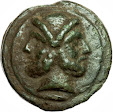The right coin -
Caps
of the Dioscuri Æ Cut As
Photo from Roma Numismatics Ltd.
Caps of the
Dioscuri Æ As. Rome, 169-158 BC.
Obv - Laureate head
of Janus; above l.
Rev - Prow right;
above caps of the Dioscuri; before l; [ROMA] below.
Crawford 181/1.
10.19g, 31mm.
Good Fine.
The left coin above is shown below with the best example I could find on line.
Q.
Caecilius Metellus Æ Semis
Photo from Roma Numismatics Ltd
Photo from ACR
Q. Caecilius
Metellus Æ Semis. Rome, AD 130.
Obv - Laureate head
of Saturn right; S behind
Rev - Prow of
galley right; [Q•METE] above, S before, ROMA in exergue.
Crawford 256/2a.
4.55 g, 2h. I
measure 22.3 to 23.5 mm to outside edges.
Good Fine.
I think the seller
was conservative when they graded this coin gF. Most of the details that were
on the coin when struck are still there. The flan was thin and low weight. I
found 21 examples on line and in books and their average weight was 7.7 grams. There
was not enough to fill some of the higher points of the die. It looks like a
re-purposed coin that was hammered into a thinner round shape and then struck. Another
possibility is the Semis was struck on Triens or Quadrans flan.
The following is information I normally store on a spreadsheet on some of my RR coins. It compares my coin to others.
Weight, grams 4.54
Weight - max 10.4
Weight - min 4.54, the next lightest coin was 6.1 gr
Weight - avg 7.7
Weight - st dev 1.3
Number 21
Diameter - max 23.5
Diameter - min 22.3
Diameter - max 24.0
Diameter - min 19.0
Diameter - avg 21.9
Dia st dev 1.3
Cr 256
/ 2a
BMCRR Rome 1056 - 1059
Sear: 877
Bab Caecilia
22
CRR 510
NMWar 362 – 363
Grade, me VF, not much wear
Grade, seller gF, probably right, not much to look at
Centering Well centered
Strike good strike, but thin flan so high points
missing
Flan flaws thin, low weight flan
Style average, meaning not too exciting
Patination brown
Damage none, but uneven tone giving less
desirable eye appeal















